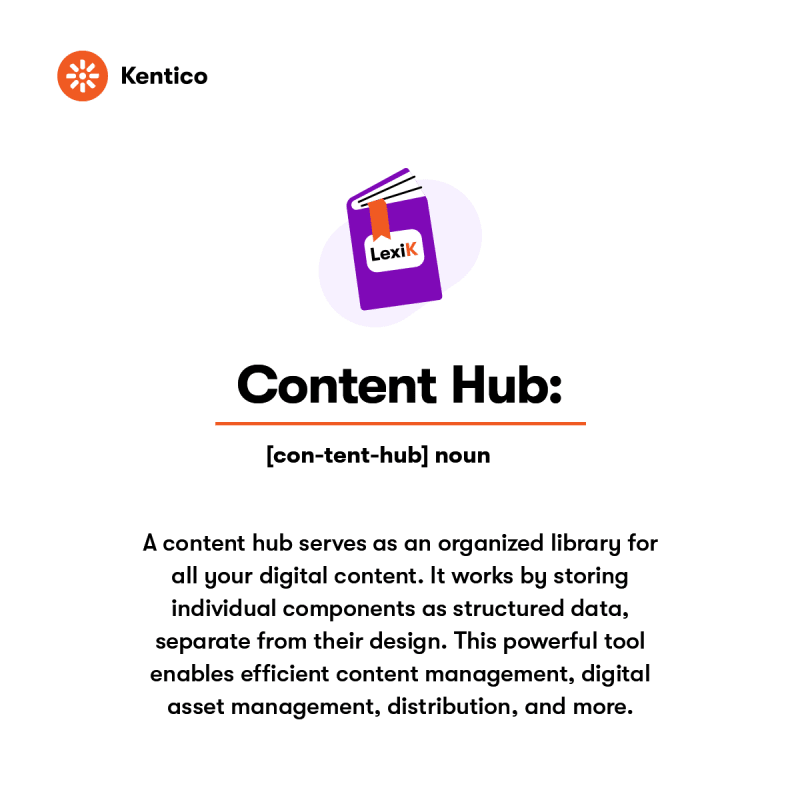Websites are still the central point of digital presentation for most companies, but managing content across multiple channels is becoming inevitable. At the same time, it doesn’t mean we have to create a chaotic amount of assets for different sites, social media, and mobile apps.
Four benefits of a content hub
A digital experience platform (DXP) that includes a content hub enables marketers to manage all types of content in one place and reuse it across multiple channels. Embrace structured data for SEO success and delight new marketing colleagues with clearly organized content storage.

1. Create consistent user experience across channels
Nowadays, organizations strive to engage with their audiences on their websites, mobile apps, and social media, and maintaining a unified experience is becoming a challenge. This is where a content cub steps in as the "single place of truth."
It works as a centralized library for all content and digital assets and ensures that every information is stored in one accessible location. When you change content in the content hub, it changes everywhere you use it.
Imagine that your company decides to update its brand slogan. The old content management system needed manual updates for every place the slogan appeared, causing inconsistencies and wasting time.
But if you have a content hub, it serves as a single place of truth where the slogan lives. When you change it there, it automatically updates everywhere and your audience will immediately see the new slogan in all places.
2. Work with maximum efficiency
A content hub makes marketers' work easier and more efficient by enabling the "create once, use it anywhere" approach. It serves as a central repository where marketers can create and store pieces of content as structured data. This means they can focus on crafting high-quality content without worrying about the design at first.
Let's consider a marketing team launching a new product. They created a blog post in the content hub that describes the product. They also added the first customer's testimonial. Now they want to share in it in a newsletter and on social channels.
Instead of starting from scratch, they can use the blog components as a starting point. They can use the product image on their homepage and list its benefits in a newsletter, share the testimonial on social media, and add some information to a landing page.
3. Structure your data for SEO stardom
When you use a content hub, your content is organized in a structured way. Instead of storing your copy as a pile of text, the content hub breaks it down into elements called content items. Each content item represents specific information, such as a headline, paragraph, image, or product description.
If you add relevant keywords, metadata, and descriptive tags, it becomes easier for search engines to understand and index the content accurately.
| Structured content is digital content organized into standardized components or "content items". These items are separated from the final design, such as font size or image position. It makes it easier to update your content, reuse it across channels, and split it into categories. On top, it helps optimizing content for search engines and creating a consistent user experience. |
For instance, imagine a company that relies on organic traffic from its blog articles. Its editing team saves each article as a content item with fields for the headline, date, summary, metadata, and the text body. The metadata helps it rank higher in search engines. And their homepage displays cards with headlines and an overview of the latest articles sorted by the publication date.
4. Save energy and space
When you store the same content in several places online, it occupies valuable space in data centers, leading to increased power consumption and slower systems. But when you use a content hub and smartly share content across channels, you avoid redundant data storage which results in a faster system and lighter processes.
For example, think about a manufacturing company managing several websites. They can store product images, technical specifications, and instructions within a single content hub. This saves them from duplicating their content on each website, speeds their database up and makes it lighter and easier to manage.
Do you want to know how it works in Kentico?
Key traits to look for
When seeking a digital experience platform with a robust content hub, several key factors come into play.
DXP with a built-in content hub
First and foremost, the content hub should be built into the system. That way, it works smoothly with the tools for content management and digital marketing within the platform, so no integrations are needed.
This convenience translates into increased efficiency and a more satisfying user experience for marketers.
Respect for intuitive workflow
A good content hub should also respect intuitive workflows. It should align with how content creators and marketers naturally work, minimizing the learning curve and maximizing productivity.
When content creators build a web page, they can add structured content from their WYSIWYG editing straight into their content hub. This lets them concentrate on making engaging content instead of dealing with difficult tools.
Hybrid headless architecture
A digital experience platform with a content hub should enable the implementation as a headless or composable solution. But it shouldn't be limited to that.
That way, you get a complete solution within one system and you keep the option to deliver content to various channels and endpoints independently in the future. This is called a hybrid headless approach, and it ensures that the system is future-proof and ready to adapt to a fast pace of growth.
Build high on solid DXP foundations
A content hub serves as the cornerstone of efficient and effective content management. If you store all digital content and assets in one easily accessible repository, you can deliver a consistent user experience with minimum effort. With a "create once, use it anywhere" approach,you can work more efficiently and focus on crafting high-quality content without worrying about the design at the initial stage.
Additionally, storing content as structured data in the content hub brings many benefits, from SEO to reusability. When you look for a digital experience platform, choose one with a built-in content hub that enables you to keep your natural workflow and ensures adaptability to future content delivery demands.
Discover how it works in Kentico

The content hub multichannel content story
Xperience by Kentico Content Hub - How it works
- Out-of-the-box content hub – ready to be used with other digital marketing tools in Kentico
- Ready for intuitive page building – Use the content hub items in Page Builder widgets
- All content types in one place – A single app in the DXP for your texts, media, files, and more
- Structured data – To add an item to the content hub you fill out a clear form with predefined fields
Download a free guide! Discover how you can create multichannel content in Xperience by Kentico. Download the free How-to guide: Content Hub.

